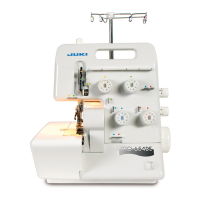31
Before you call for help: Trouble and corrective measures
serusaem evitcerroC)nosaer( esuaCTrouble Page
• Presser foot pressure is too low. Increase the presser foot pressure by turning the
presser foot pressure adjusting screw to the right.
Fabric does not
feed
10
When the trouble is not corrected by the above measures, contact your local dealer.
The followingproblems should not be regarded as the machine trouble. Check the following table before you call for help from us.
Problemas y medidas correcticas antes de que usted pida ayuda.
savitcerroc sadideMsasuaCProblemas Página
• Presión del pie prensatelas demasiado bajo. Aumente la presión del pie prensatelas girando
hacia la derecha el tornillo de ajuste de presión.
No avanza la tela
10
When the trouble is not corrected by the above measures, contact your local dealer.
Los siguientes problemas no se deben considerar como problemas de la máquina. Antes de que usted se dirija a nosotros
pidiendo ayuda compruebe la siguiente tabla.
Needles break • Needles are bent, or the needle point is blunt.
• Needles are incorrectly attached.
• The material cloth is excessively stretched.
Replace the needles.
Attach the needle correctly.
Hold the edge of the material cloth lightly with your
hand when sewing.
11
11
-
Thread breaks • The machine is incorrectly threaded.
• Thread tension is too high.
• Needles are incorrectly attached.
Rethread the machine correctly.
Adjust the thread tention properly.
Adjust the needles correctly.
12-16
20,21
11
Stitch skips
• Needles are bent or needle point is blunt.
• Needles are incorrectly attached.
• The machine is incorrectly threaded.
Replace the needles.
Attach the needle correctly.
Rethread the machine correctly.
11
11
12-16
Poor stitches are
formation
• Thread tension is not proper.
Adjust the thread tention properly.
20,21
Seams flute or
wave, especially
when sewing knits
• Presser foot pressure is too high.
* Differential feed is set incorrectly.
Reduce presser foot pressure.
* Adjust differential feed to N - 2.
10
25
Seams pucker • Thread tension is too high.
* Differential feed is set incorrectly.
Set the thread tention adjusting dial to the smaller
value.
* Adjust differential feed to 0.7 - N.
20,21
25
Motor trouble • The motor makes noise.
• The motor will not rotate.
• Unusually large sparks are emitted.
-.hsurb nobrac eht ecalpeR
Agujas rotas • Las agujas están dobladas o la punta roma.
• Las agujas están mal puestas.
• La tela está demasiado tirante.
Cambie las agujas.
Póngalas correctamente.
Sostenga el borde de la tela con su mano cuando
está cosiendo.
11
11
-
Hilos rotos • La máquina está mal enhebrada.
• Tensión del hilo demasiado alta.
• Las agujas están mal puestas.
Vuelva a enhebrarla correctamente.
Ajuste la tensión del hilo adecuadamente.
Póngalas correctamente.
12-16
20,21
11
Omisión de
puntadas
• Las agujas están dobladas o la punta roma.
• Las agujas están mal puestas.
• La máquina está mal enhebrada.
11
11
12-16
Cambie las agujas.
Póngalas correctamente.
Vuelva a enhebrarla correctamente.
Se forman punta-
das deficientes
•
Tensión del hilo inadecuada. 20,21Ajuste la tensión adecuadamente.
Rebaje la presión del pie prensatelas.
* Ajuste el transporte diferencial a N - 2.
Costuras rizadas
u onduladas
especialmente al
coser géneros de
punto
• La presión del pie prensatelas es demasiado
alta.
* El transporte diferencial está ajustado
incorrectamente.
10
25
Ajuste la tensión del hilo con el disco de ajuste de
tensión a un valor inferior.
* Ajuste el transporte diferencial a 0.7 - N.
Las puntadas
forman fruncido
• Tensión del hilo demasiado alta.
* El transporte diferencial está ajustado
incorrectamente.
20,21
25
Problema en el
motor
• El motor hace ruido.
• El motor no funciona.
• Emite grandes chipas anormales.
-Cambie la escobilla de carbón.

